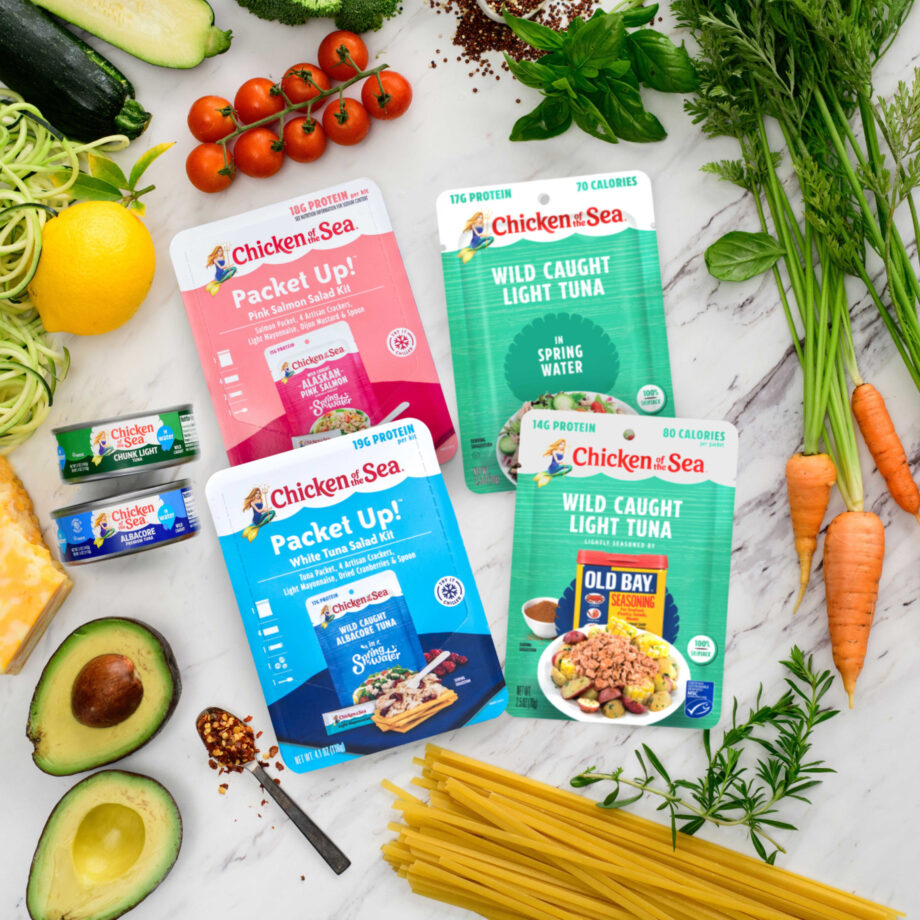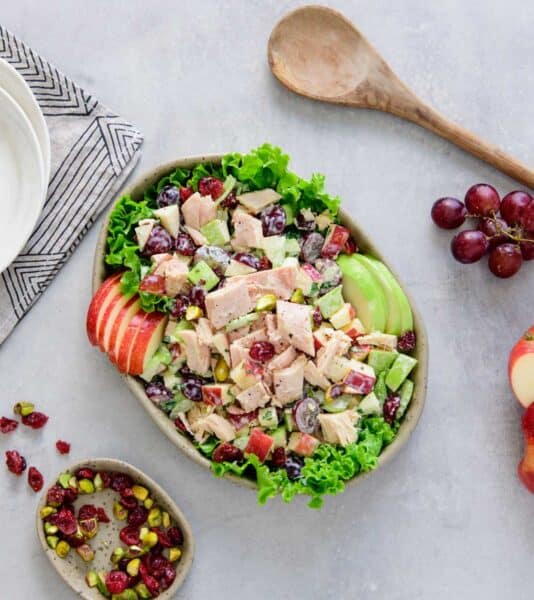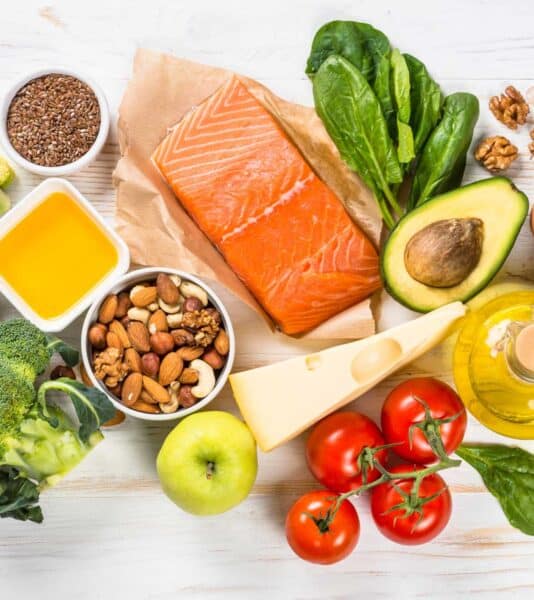What is a Pescatarian Diet?
A pescatarian diet refers to a vegetarian diet with the addition of seafood. Pescatarian, a term introduced in the early 1990s, blends the Italian word “pesce,” meaning fish, with “vegetarian.” Plant-based foods such as fruits, veggies, beans, whole grains, lentils, nuts, and seeds supply many vitamins, phytochemicals, and minerals, and seafood provides protein and omega-3 fatty acids. Some pescatarians (people who follow this way of eating) consume animal products such as eggs and dairy but all pescatarians avoid red meat and poultry.
What Are the Best Health Benefits of a Pescatarian Diet?
Here are the top four health benefits of adding fish to a vegetarian diet.
1) Lean Protein Builds Muscles, Skin, and Bones
Seafood is an excellent source of lean, complete protein. For example, a 5 ounce can of tuna in water contains 30 grams of protein and only 1 gram of saturated fat. Plus, about 90% of a can of tuna calories come from protein. Chicken, pork, beef, and other animal meats might contain similar levels of protein but will have higher levels of saturated fat.
2) Healthy Omega-3 Fats Support a Healthy Heart
Most Americans don’t eat enough seafood, which features high levels of omega-3 fatty acids. For example, salmon and tuna contain the two main types of omega-3s–eicosapentaenoic acid (EPA) and docosahexaenoic acid (DHA). Research shows that these fatty acids play a key role in the inflammatory pathways in the body as well as support a healthy heart, eyes and brain.
3) Limiting Red Meat is Good for You, and for the Planet
Reducing or eliminating red meat from your diet may improve your heart health. In fact, according to one study, pescatarians live longer than people who consume red meat and poultry. Also, land animals raised for food, especially cows, put a strain on our environment by requiring excessive natural resources to raise them and by emitting pollution in the form of methane.
4) All the Benefits of a Vegetarian Diet
Let’s not forget that the pescatarian diet consists primarily of plant foods. Extensive research has shown that following a plant-based diet may contribute to a lower risk of heart issues, a lower risk of obesity, improved blood lipids and lower blood pressure, and lower risk of type 2 diabetes and metabolic syndrome compared to meat-eaters. Vegetarian diets are also high in antioxidant and anti-inflammatory agents, such as flavonoids, and provide nutrients like magnesium, vitamin B12, zinc, and fiber.
What Are the Biggest Challenges of a Pescatarian Diet?
Getting enough iron. Eliminating red meat from your diet may raise your risk of iron deficiency anemia, a condition in which your body doesn’t produce enough oxygen-bearing red blood cells. But you can still get iron without eating red meat by eating foods such as tuna fish, legumes, tofu and tempeh, whole grains, dark green leafy vegetables, nuts and seeds, dried fruit, and eggs.
Mercury. According to the FDA, the mercury present in fish is not a risk for most people. However, the FDA recommends that children ages 1-11 and women who are pregnant or breastfeeding limit their tuna intake to 8-12 oz of light tuna or 4 oz of white tuna per week.
Fish that children ages 1-11 and women who are pregnant or breastfeeding should avoid include:
- Shark
- Swordfish
- King mackerel
- Tilefish
Fish low in mercury include:
- Canned light tuna
- Salmon
- pollock
- Shrimp
- Catfish
How Can I Plan a Balanced and Sustainable Pescatarian Diet?
It is possible for you to absorb all the nutrients you need on a vegetarian or pescatarian diet. However, restricting certain foods can lead to deficiencies in one or more nutrients. For example, as we discussed above, removing red meat from your diet can result in a deficiency in iron (which you can make up by eating other foods). Or, removing dairy products could result in a calcium deficiency (which you can make up with certain vegetables, beans, nuts, and seeds). That’s why you should discuss any major change in your eating habits with your doctor or a registered dietitian before you develop a meal plan.
Below are some recommended food options for your pescatarian diet:
What Seafood Should I Eat on a Pescatarian Diet?
- Fresh shellfish (clams, crab, oysters, shrimp, and scallops)
- Canned fish (salmon, tuna, mackerel, sardines)
- Canned shellfish (clams, crab, oysters, shrimp, and scallops)
- Frozen seafood (fish sticks, salmon, trout, herring, and shrimp)
- Fresh fish (salmon, cod, sardines, pollock, and catfish)
What Plant-Based Foods Should I Eat on a Pescatarian Diet?
- Vegetables
- Fruits
- Legumes (including kidney beans, peas, and pinto beans)
- Legume products (including hummus and tofu)
- Cereals and whole grains (including corn, rice, oats, bulgar wheat, and amaranth)
- Gluten-free pseudo grains (such as buckwheat and quinoa)
- Nuts and nut butters
- Seeds, such as flaxseeds, hemp seeds, and chia
- Eggs and dairy (if lacto-ovo-vegetarian)
What Foods Should I Avoid on a Pescatarian Diet?
- Chicken
- Beef
- Turkey
- Pork
- Lamb
- Wild game
Does a Pescatarian Diet Help Sustainability?
Adopting a pescatarian diet can also benefit the environment, as seafood, when responsibly sourced, often provides a more sustainable protein option than terrestrial animal products. Prioritizing wild-caught fish and avoiding meat consumption helps preserve land, water supplies, and biodiversity.
What Are Some Good Pescatarian Recipes?
- Tuna Veggie Grain Bowl: Combine cooked quinoa, tuna, sautéed cauliflower, zucchini, and asparagus. Top with cherry tomatoes, dill, and spicy mayonnaise. (full recipe)
- Salmon Southwest Salad: Combine drained salmon with mixed greens, black beans, corn, cherry tomatoes, avocado, red onion, and cilantro, then serve with lime wedges for a zesty finish. (full recipe)
- Mediterranean Tuna Salad: Combine drained tuna with halved cherry tomatoes, sliced Kalamata olives, chopped cucumber, and feta. Dress with lemon juice, olive oil, and oregano. (full recipe)
Frequently Asked Questions
Which is healthier: Pescatarian vs Mediterranean diet?
Both the pescatarian diet and the Mediterranean diet have health benefits, but they differ in some key aspects. The pescatarian diet is vegetarian with the addition of fish and seafood, while the Mediterranean diet is plant-based and includes olive oil as a primary fat source. Research suggests that both diets reduce your risks of chronic health challenges, gain less weight over time, and have a lower risk of developing diabetes compared to those who include meat in their diet.
What foods do pescatarians eat?
Pescatarians primarily consume a plant-based diet with the addition of eating fish and seafood. Their meals often include vegetables, fruits, grains, legumes, nuts, seeds, and healthy fats like olive oil. By emphasizing seafood and avoiding other meats, pescatarians enjoy a diet rich in omega-3 fatty acids and essential nutrients.
Can pescatarians eat eggs?
Yes, pescatarians can include eggs in their diet. While they primarily focus on plant-based foods and seafood, eggs are considered acceptable. Eggs contain cholesterol, but research suggests that dietary cholesterol from eggs has minimal impact on blood cholesterol levels for most people. Still, if you’re concerned about cholesterol and cardiovascular issues, consider consuming egg whites—they’re virtually cholesterol-free and still provide protein and other nutrients.
Can you lose weight on a pescatarian diet?
Yes, a balanced pescatarian diet can help support weight loss by choosing nutrient-dense foods, controlling portion sizes, and maintaining a calorie deficit. Remember to focus on whole grains, fruits, vegetables, and healthy fats while incorporating fish for protein and omega-3 fatty acids.
Sources:

Where to Buy
Overflowing with flavor, Chicken of the Sea packets and cans are ready for all your culinary adventures. Use our product locator to find the perfect salmon, tuna, crab or other seafood products from Chicken of the Sea.







